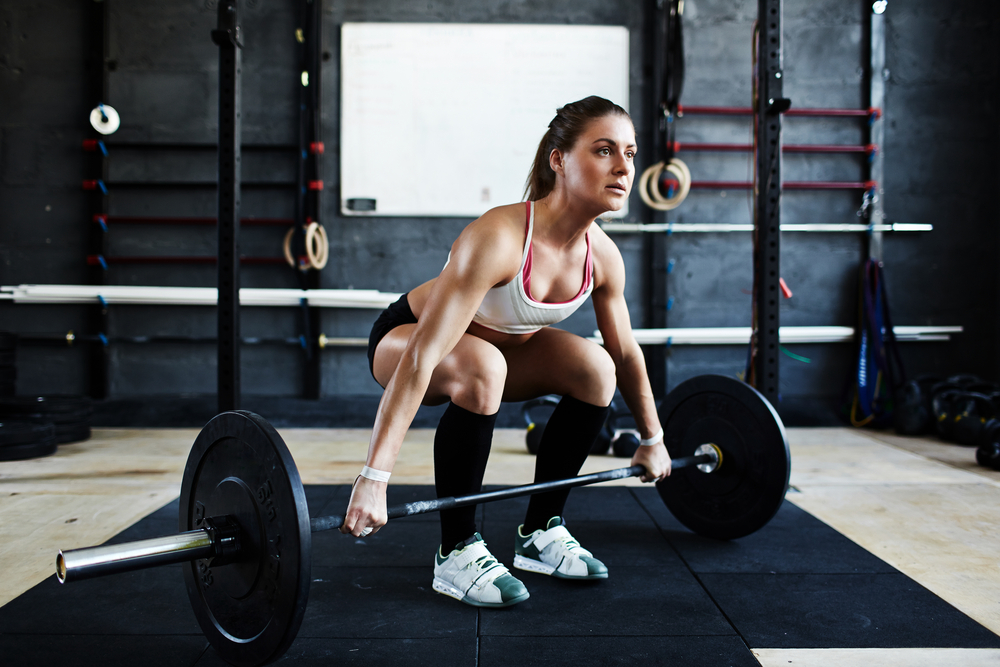A healthier life
Perfecting your deadlift starts here. This straightforward guide will take you through each step needed to execute a deadlift with precision and power.
From setting your stance to the moment of lift-off, you’ll learn how to do a deadlift step by step, safely and effectively. Avoid common pitfalls and build a foundation for formidable strength, one rep at a time.
Ready to get started? Let’s dive into the mechanics of a proper deadlift.
Key Takeaways
- The deadlift is an efficient exercise for building muscle mass and strength across multiple muscle groups when performed with proper form, which is critical for safety and effectiveness.
- Proper deadlifting technique is broken down into stance setup, grip style, and lifting execution; each element requires careful attention to detail to maximize benefits and minimize injury risk.
- Common deadlift mistakes include rounding the back, improper hip positioning, and overextending at the top; identifying and correcting these mistakes is essential for a safe and productive deadlift routine.
The Importance of Proper Deadlift Technique
When we talk about deadlifts, one phrase consistently pops up: proper deadlift form. But what exactly does it mean, and why is it so important? If you’ve ever wondered about those questions, you’re in the right place.
While proper form is paramount in all exercises, it holds particular significance in deadlifts. A deadlift engages multiple muscle groups simultaneously, making it a highly efficient exercise for building muscle mass and enhancing overall strength and functional abilities.
Executing the deadlift with proper form effectively targets and strengthens a variety of muscles. You’re working out your:
- legs
- back
- arms
- hamstrings
- quadriceps
- gluteals
- lower back muscles
But that’s not all. A well-performed deadlift is also known for developing a strong core and a V-shaped back.
You might wonder why not everyone does the deadlift, given its benefits. Well, the technique is the key determinant.
Improper deadlift form can lead to injuries and impede lifting efficiency. Rounding the lower back, for instance, can result in positional stress on the spinal discs, potentially leading to injuries such as bulges, nerve compression, and pain. Moreover, an improper bar path can elevate the risk of injury.
How do you go about maintaining the right form? Simple – feet shoulder-width apart. This positioning provides a stable base to lift the weight and maintain balance. To deadlift safely, remember to:
- Keep the bar as close as possible to your body
- A vertical line should pass from the bar to your midfoot
- Your shins should touch the bar at the start of the lift
Another key aspect of maintaining the correct form is keeping the spine neutral throughout the lift. A neutral spine helps distribute the load evenly across your body, reducing the risk of injury as the weight increases. In addition to the spine, keep your arms straight and grip the bar tightly. This mixed grip can help improve your grip strength, allowing you to lift heavier weights.
Step-by-Step Guide to Perfect Deadlift Form
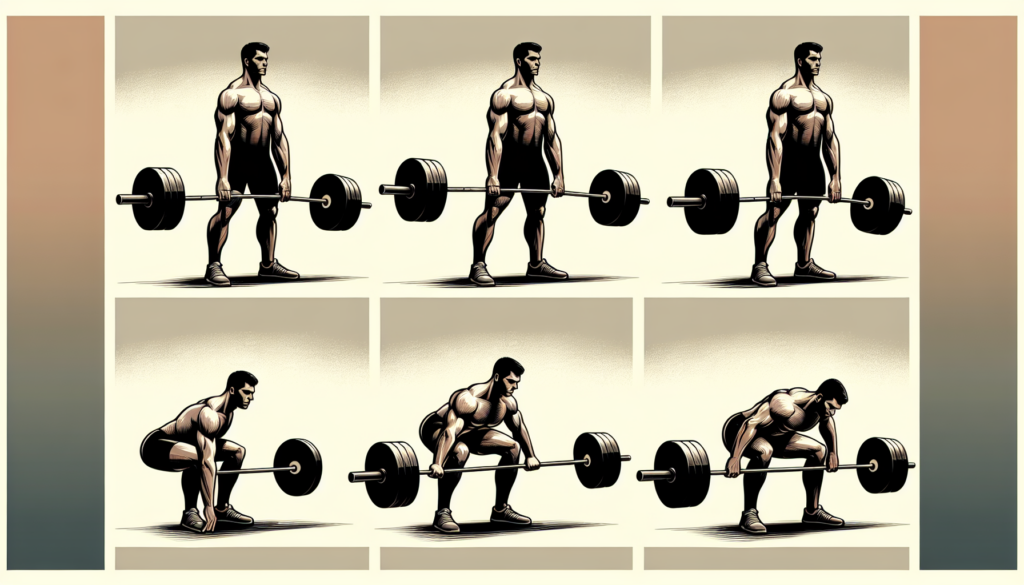
Understanding the importance of the correct form, let’s deconstruct the deadlift into its individual elements.
The deadlift can be split into three main parts: setting up your stance, gripping the bar, and lifting the weight. Performing each of these steps correctly will ensure you’re executing the deadlift with optimal form.
Setting Up Your Stance
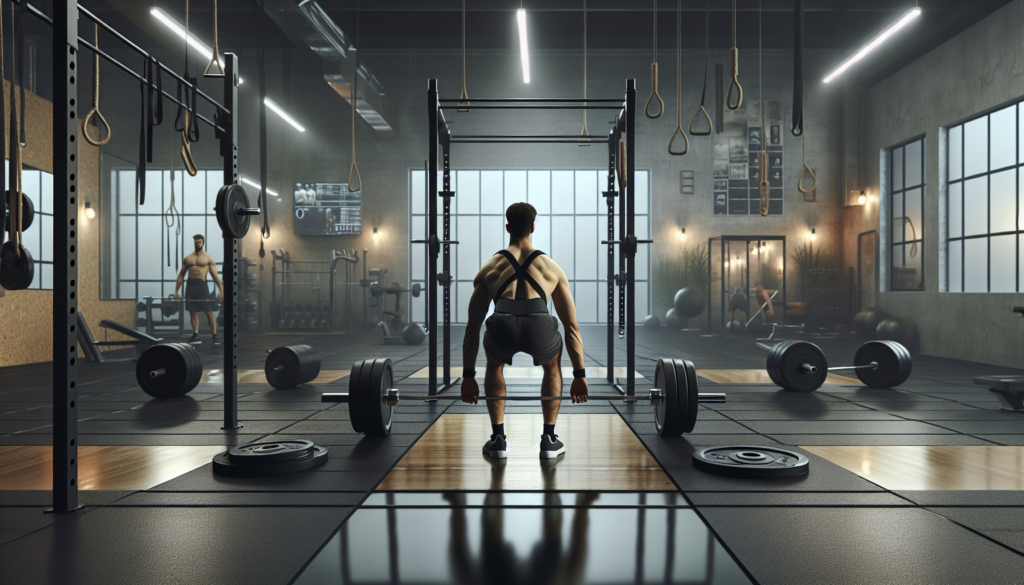
Although it may appear straightforward, setting up your stance for a deadlift involves more than merely standing before the barbell. Your stance sets the foundation for your lift and directly influences your form throughout the exercise. Start by positioning your feet according to your build. Your heels should be approximately hip-width apart, with your toes pointing forward or slightly turned out at around 15 degrees.
The next important aspect of your stance is your hip height. Contrary to popular belief, there’s no universal ‘correct’ hip height for deadlifts. Your ideal hip height depends on your individual limb lengths. A good rule of thumb is to start each repetition from a half squat position.
Your shins’ alignment with the barbell is another crucial factor to consider. The ideal alignment involves a slight incline of the shins when observed from the side, with the shins touching the barbell only when bending over to grip it. This approach helps maintain balance and minimize strain on the lower back by ensuring the bar doesn’t push away from the mid-foot.
Lastly, let’s talk about your spine. Maintaining a neutral spine is crucial when preparing for a deadlift. It is essential to:
- Preserve the spine’s natural alignment
- Minimize the risk of injury, particularly to the lower back
- Establish a sturdy foundation for lifting the weight.
In summary, the proper way to set up your stance for a deadlift is to position your feet hip-width apart, align your shins with the barbell, and maintain a neutral spine. This positioning will help you lift the weight efficiently and safely, allowing you to add weight to your deadlift over time.
Gripping the Bar
Although it may appear straightforward, setting up your stance for a deadlift involves more than merely standing before the barbell. Your stance sets the foundation for your lift and directly influences your form throughout the exercise. Start by positioning your feet according to your build. Your heels should be approximately hip-width apart, with your toes pointing forward or slightly turned out at around 15 degrees.
The next important aspect of your stance is your hip height. Contrary to popular belief, there’s no universal ‘correct’ hip height for deadlifts. Your ideal hip height depends on your individual limb lengths. A good rule of thumb is to start each repetition from a half squat position.
Your shins’ alignment with the barbell is another crucial factor to consider. The ideal alignment involves a slight incline of the shins when observed from the side, with the shins touching the barbell only when bending over to grip it. This approach helps maintain balance and minimize strain on the lower back by ensuring the bar doesn’t push away from the mid-foot.
Lastly, let’s talk about your spine. Maintaining a neutral spine is crucial when preparing for a deadlift. It is essential to:
- Preserve the spine’s natural alignment
- Minimize the risk of injury, particularly to the lower back
- Establish a sturdy foundation for lifting the weight.
In summary, the proper way to set up your stance for a deadlift is to position your feet hip-width apart, align your shins with the barbell, and maintain a neutral spine. This positioning will help you lift the weight efficiently and safely, allowing you to add weight to your deadlift over time.
Lifting the Weight
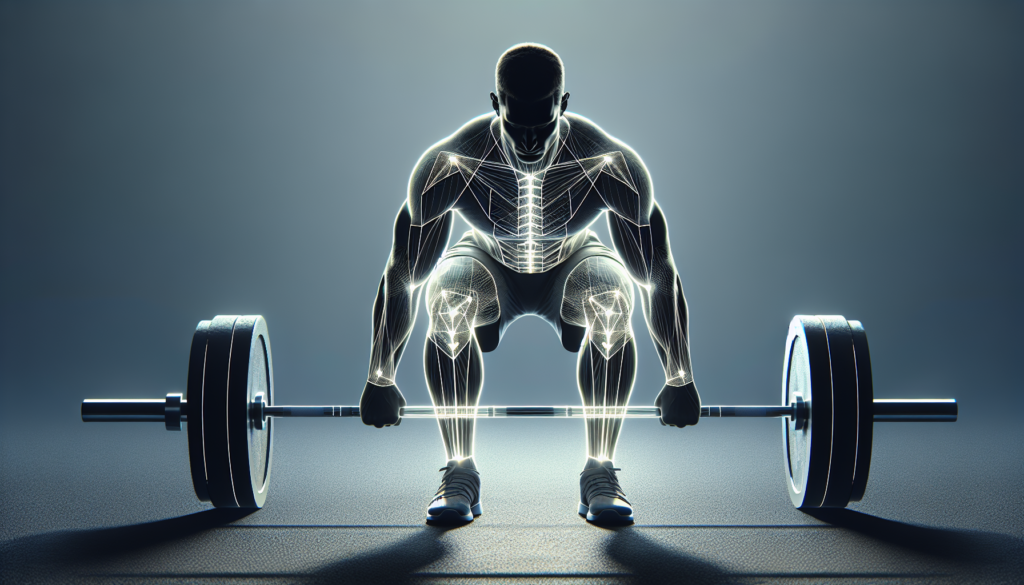
With your stance established and the bar gripped, you can now proceed to lifting the weight. The lifting phase of the deadlift involves engaging your muscles and moving the weight from the floor to a standing position. While performing a deadlift, it is recommended to engage the muscles in your legs, hips, and core.
Before you start lifting, it’s crucial to set yourself up correctly. ‘Setting’ in the deadlift involves creating tension in your body at the starting position to effectively engage your muscles when lifting the bar. This technique helps activate the correct muscles and maintain proper form throughout the exercise.
To lift the weight, follow these steps:
- Start by pushing through your feet, similar to a leg press.
- As you lift the weight, make sure your hips and chest rise simultaneously, keeping your spine neutral throughout the movement.
- The path of the bar during a deadlift should be a straight vertical line.
- It’s crucial to avoid any horizontal movement of the bar, as this can increase the strain on your lower back and make the lift harder.
Finally, as you reach the top of the lift, lock your hips and knees. This position signifies the end of one repetition of the deadlift. Once you’ve completed the lift, lower the weight back down, reset your form, and prepare for the next rep.
Common Deadlift Mistakes and How to Fix Them
While deadlifting is extremely beneficial, mastering it can pose a challenge. Even experienced lifters can make mistakes that can hinder their progress and potentially lead to injury.
We will now explore some of the frequent deadlift errors and how to rectify them.
Rounding the Back
One of the most common mistakes in deadlifting is rounding the back. This form error can lead to uneven pressure on your spinal discs, potentially resulting in injuries like herniated discs and chronic back pain.
Rounding the back usually occurs when you’re trying to lift too much weight. When the weight is too heavy, your back muscles may not be strong enough to maintain a neutral spine, leading to a rounding of the back.
To prevent rounding your back, it’s essential to engage your core, keep your chest up, and maintain a neutral spine throughout the lift. Practicing these techniques can help you maintain proper form even as the weight increases.
If you notice that you’re rounding your back during your deadlifts, it might be helpful to decrease the weight and focus on your form. Once you can maintain a neutral spine with a lighter weight, gradually increase the weight while ensuring your form stays correct.
Maintaining a neutral spine is important for:
- Preventing injury
- Effectively engaging your muscles during the lift
- Evenly distributing the load across your body
- Allowing for a more efficient lift
In summary, to fix the issue of rounding your back in the deadlift, reduce the weight, focus on maintaining a neutral spine, and gradually increase the weight while ensuring your form remains correct.
Improper Hip Positioning
Another common mistake in deadlifting is improper hip positioning. Your hip position affects how the load is distributed throughout your body, and improper positioning can lead to inefficient lifts and increased risk of injury.
The optimal hip height for deadlifting can vary depending on your body type. For example, if you have long legs, you may need to position your hips higher compared to someone with shorter legs.
One of the most common issues with hip positioning is starting with the hips too low. This can put more strain on your knees and turn your deadlift into more of a squat movement. To fix this, make sure your hips are higher than your knees and lower than your shoulders before you start the lift.
An additional concern is allowing your hips to rise faster than your chest when performing the movement. This can affect the overall form and effectiveness of the exercise. This can put extra stress on your lower back and make the lift harder. To fix this, focus on raising your hips and chest at the same time as you lift the weight.
In summary, to fix improper hip positioning, adjust your hip height based on your body type and ensure your hips and chest rise at the same time during the lift.
Overextending at the Top
Overextending at the top of the deadlift is another common mistake. This happens when lifters lean back or shrug their shoulders at the top of the lift, which can lead to unnecessary strain and potential injury.
Leaning back at the top of the lift can put extra pressure on your lower back and spinal discs. Instead of leaning back, focus on locking your hips and knees, and standing tall at the top of the lift with your hips forward.
Shrugging your shoulders at the top of the lift can also be problematic. This unnecessary movement can put extra strain on your shoulder muscles and potentially lead to injuries. Instead of shrugging your shoulders, focus on keeping them relaxed and down.
It’s also important to note that overextending at the top of the lift doesn’t add any extra benefits to the exercise. The main muscles worked in the deadlift – the glutes, hamstrings, and back muscles – are fully engaged without the need for overextension.
In summary, to fix overextending at the top of the deadlift, focus on standing tall with your hips and knees locked, and keep your shoulders relaxed and down. This will ensure you’re performing the lift safely and effectively.
Deadlift Variations for Different Goals
Much like there are several ways to achieve a goal, there are multiple ways to execute a deadlift. Depending on your individual fitness goals and body type, you might find that certain variations of the deadlift are more beneficial for you.
We will now delve into some prevalent deadlift variations and their role in helping you attain your fitness objectives.
Romanian Deadlift
The Romanian Deadlift is a popular variation that focuses on the posterior chain – the muscles on the backside of your body. Unlike the conventional deadlift, Romanian deadlifts start from a standing position and target the hamstrings and glutes.
When executing a Romanian deadlift, your knees should have a slight bend, but your legs should remain straight throughout the exercise. This form allows for a significant stretch in the hamstrings, which can lead to increased flexibility and muscle development.
The Romanian deadlift is an excellent exercise for individuals looking to improve their posterior chain strength. It’s particularly beneficial for athletes who rely on these muscles for performance in sports like sprinting and jumping.
However, like any exercise, it’s crucial to perform the Romanian deadlift with proper form to avoid injury and get the most benefits. Always start with a lighter weight until you’re comfortable with the movement and can maintain proper form.
In summary, the Romanian deadlift is a great exercise for targeting the hamstrings and glutes and can be a beneficial addition to your strength training routine.
Sumo Deadlift
The Sumo Deadlift is another variation that targets different muscle groups compared to the conventional deadlift. The sumo stance, characterized by a wider foot placement, targets the groin and quads more than the conventional stance.
The sumo deadlift begins with the feet wider than shoulder-width apart, with the toes pointing outwards. This setup allows for a more upright torso during the lift, which can be beneficial for individuals with back issues as it places less strain on the lower back.
One of the main benefits of the sumo deadlift is that it allows you to lift heavier weights. The wider stance and more upright torso position reduce the range of motion required for the lift, which can allow you to lift heavier weights compared to the conventional deadlift.
However, the sumo deadlift requires a high degree of flexibility in the hips and groin, so it may not be suitable for everyone. Always start with a lighter weight and increase gradually as you become more comfortable with the movement.
In summary, the sumo deadlift is a useful variation for those looking to target the groin and quads or lift heavier weights. However, it requires good hip and groin flexibility, so it may not be suitable for everyone.
Stiff-Legged Deadlift
The Stiff-Legged Deadlift is a variation that emphasizes the hamstring and lower back muscles. Unlike the conventional deadlift, the stiff-legged deadlift involves keeping the legs almost completely straight, which places more tension on the targeted muscles.
The stiff-legged deadlift is an excellent exercise for increasing hamstring flexibility and strength. The straight leg position provides a substantial stretch for the hamstrings, which can lead to increased flexibility and muscle development.
Stiff-legged deadlifts are also beneficial for improving lower back strength. The straight leg position places greater emphasis on the lower back muscles, making them work harder to lift the weight.
However, like any exercise, it’s crucial to perform the stiff-legged deadlift with proper form to avoid injury and get the most benefits. Always start with a lighter weight until you’re comfortable with the movement and can maintain proper form.
In summary, the stiff-legged deadlift is an effective exercise for targeting the hamstrings and lower back muscles and can be a valuable addition to your strength training routine.
Proper Equipment and Accessories for Deadlifting
Equipping yourself with the appropriate gear can considerably enhance your performance in deadlifting. From the type of barbell you use to the shoes on your feet, each piece of equipment plays a role in your deadlift form and the amount of weight you can lift.
The conventional barbell deadlift is the cornerstone of your deadlifting equipment. An Olympic Barbell with a 28mm diameter, revolving sleeves, and sharp, deep knurling that doesn’t cover the bar’s center is highly recommended for deadlifting.
The weight plates you use also play a crucial role in your deadlift performance. Round iron plates with 50mm holes are the preferred choice for deadlifts. Avoid hex plates as they can cause the bar to move unpredictably, potentially leading to poor form and injury.
When it comes to footwear, shoes with thin, flat, hard soles or deadlift slippers are recommended. These types of shoes provide stability and maintain proximity to the floor, which is beneficial for maintaining proper form.
Chalk can also be a useful accessory for deadlifting. It can improve your grip on the bar, allowing you to lift heavier weights. If you’re experiencing hand pain or developing calluses from deadlifting, chalk can help by creating a smoother surface on your hands.
In summary, having the right equipment and accessories, including a quality barbell, appropriate weight plates, flat-soled shoes, and chalk, can significantly improve your deadlift performance.
Safety Tips and Precautions
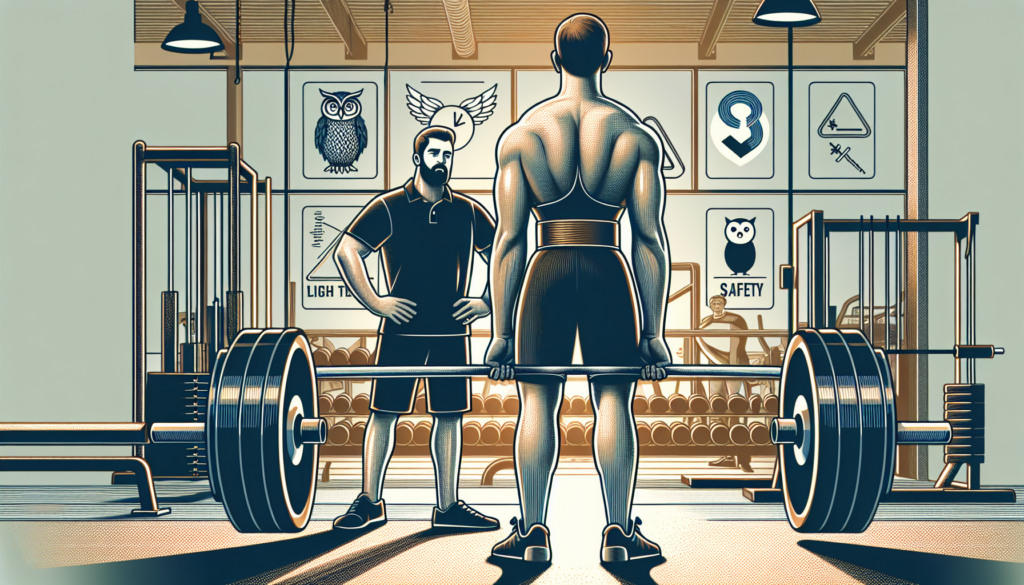
As with any exercise, deadlifting carries potential hazards. However, with appropriate precautions, these risks can be mitigated, ensuring safe and effective lifting. Here are some safety tips to keep in mind when deadlifting.
First, start with light weights. If you’re new to deadlifting, it’s advisable to start with just the bar. This allows you to focus on mastering the form before adding more weight.
Second, seek professional guidance. If you’re new to deadlifting, it can be beneficial to get some coaching. A trainer can provide feedback on your form and help you avoid common mistakes that could lead to injury.
Third, listen to your body. If you feel any discomfort while deadlifting, stop the exercise immediately. It’s crucial to pay attention to any signs of pain or discomfort and address them promptly to prevent potential injuries.
In summary, deadlifting is a highly beneficial exercise, but it’s crucial to take the necessary precautions to ensure you’re lifting safely. By starting with light weights, seeking professional guidance, and listening to your body, you can reap the benefits of deadlifting while minimizing the risks.
Summary
In conclusion, the deadlift is a powerful exercise that can transform your fitness game by working multiple muscle groups in a single move. However, like any potent tool, it must be wielded correctly to harness its benefits and avoid injury. By following the guidance in this blog, you’ll be equipped with the knowledge to execute a deadlift with perfect form, avoid common mistakes, and achieve your fitness goals safely and effectively.

